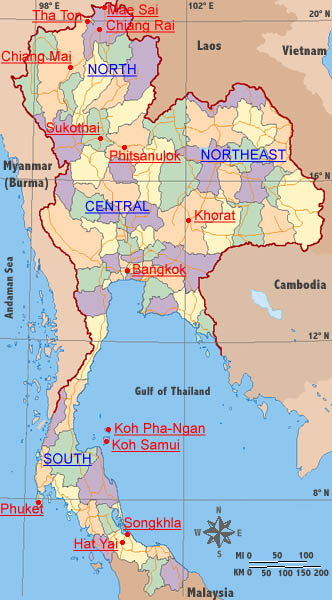

for the Thai language
 |  | Internet resource for the Thai language |
F.A.Q. Check out the list of frequently asked questions for a quick answer to your inquiry
recent donations!
Sign-up to join our mailing list. You'll receive email notification when this site is updated. Your privacy is guaranteed; this list is not sold, shared, or used for any other purpose. Click here for more information.
To unsubscribe, click here.
 [introduction]
[introduction]Click on the underlined areas for tips on regional activities. This map provides information on some of the more popular—and not so popular—tourist destinations! In 1995, Thailand had a population of 59,460,382, with close to 15% living in the capital city of Bangkok. The population growth rate is less than 2% per year. The tourist will find it useful to consider four regions of the country: the North, with scenic mountains and interesting ethnic minority populations; the Central region, an incredibly rich agricultural basin that makes Thailand the world's largest exporter of rice; the Southern peninsula, which features idyllic beaches, Muslim- and Chinese-influenced culture, and some of the best scuba diving in the world; and the Northeast, a relatively poor plateau region scattered with fantastic 12th century Angkor period ruins of the Khmer Empire. Bangkok, a frenzied world unto itself, can be considered a fifth unique area of Thailand. As you can see from the map, Thailand is politically divided into around 75 provinces. These are administered by governors appointed by the Ministry of the Interior. The Kingdom of Thailand is a constitutional monarchy (such as in Great Britain) under His Majesty Bhumibol Adulyadev, Rama IX. Citizens vote for a prime minister and for members of one legislative body; members of the less-powerful Senate are appointed by the prime minister. The unique Thai language is spoken throughout Thailand, and the literacy rate is very high. To learn to speak Thai or read an overview and brief history of the language, visit thai-language.com. |